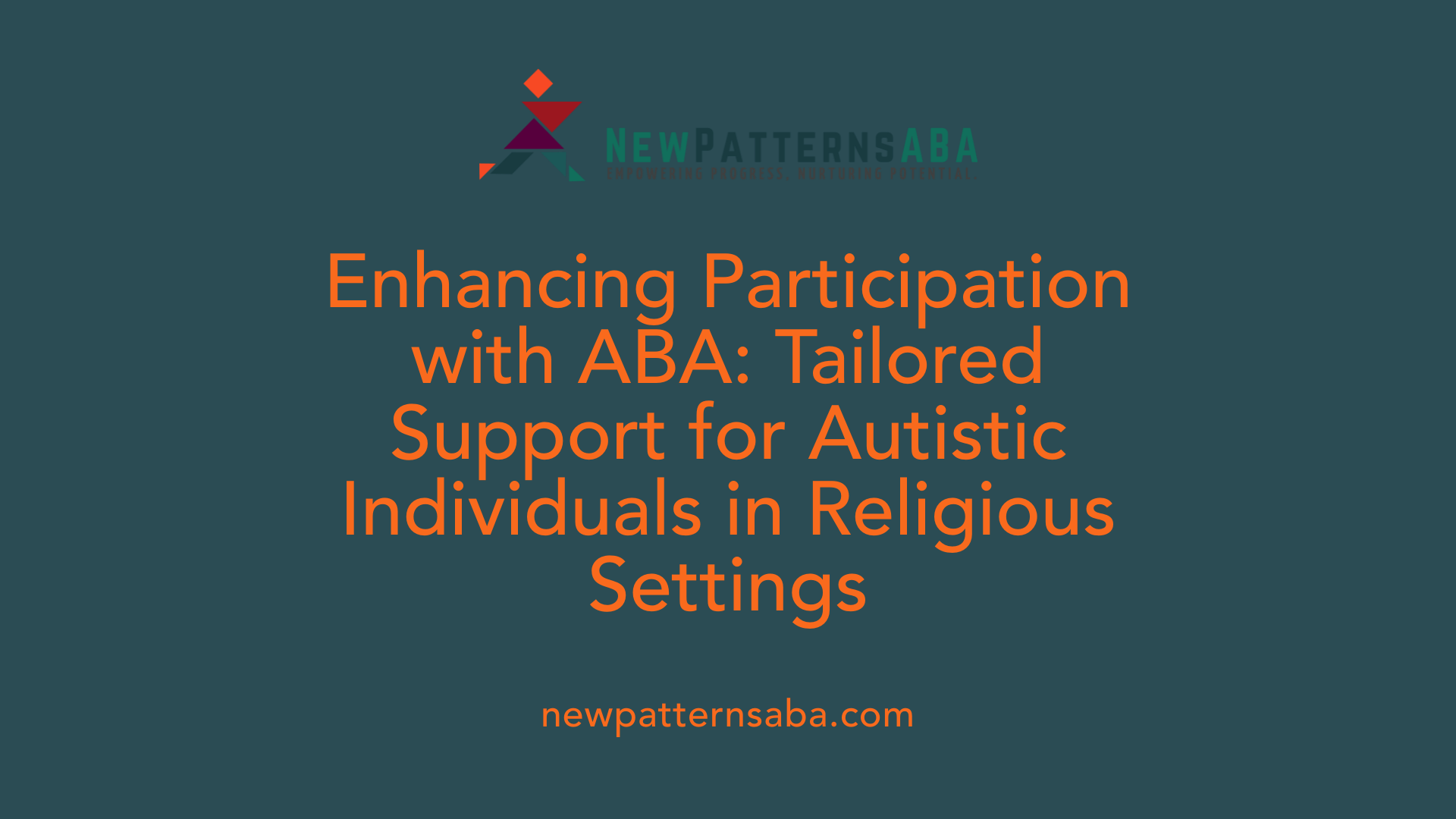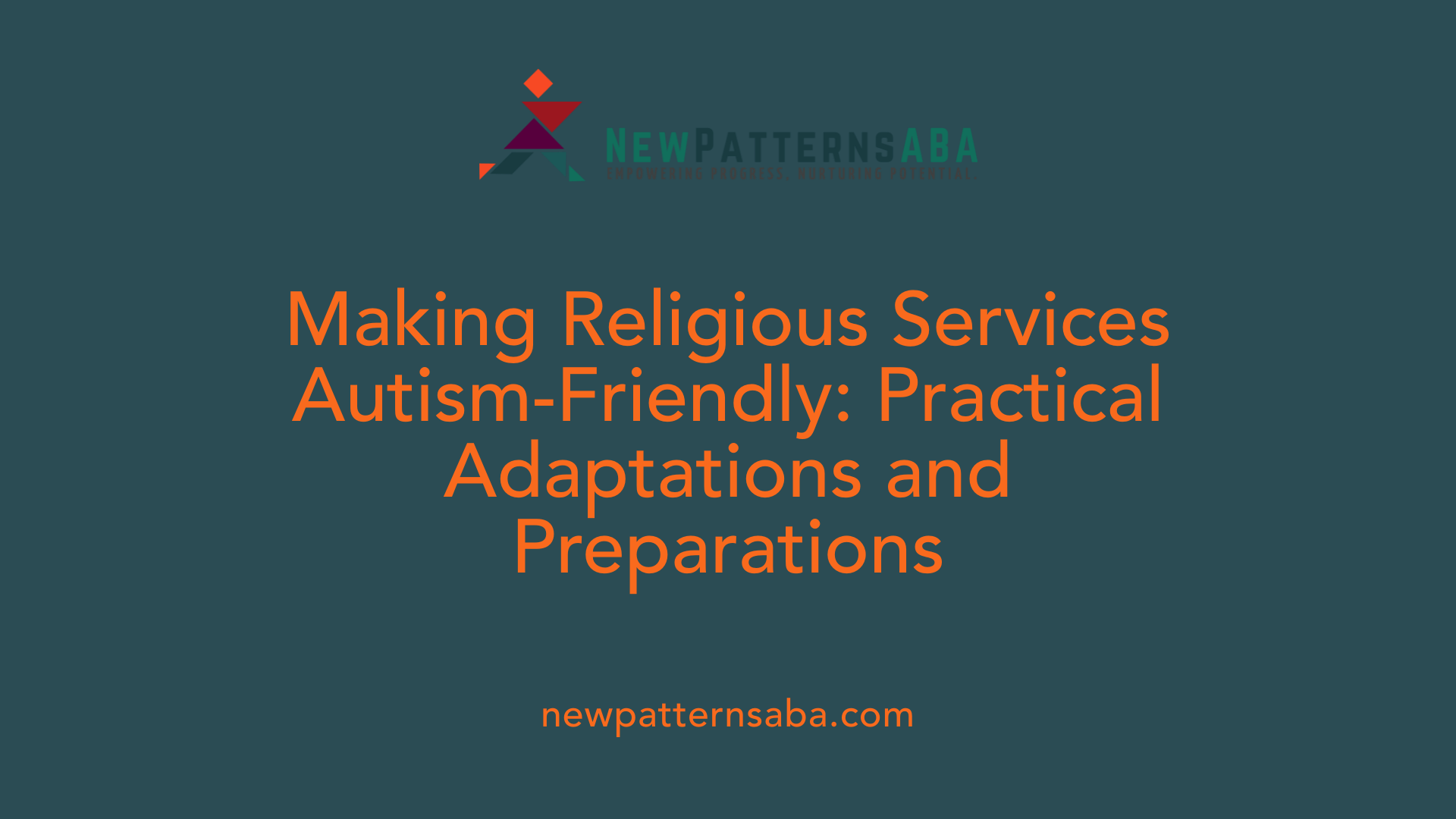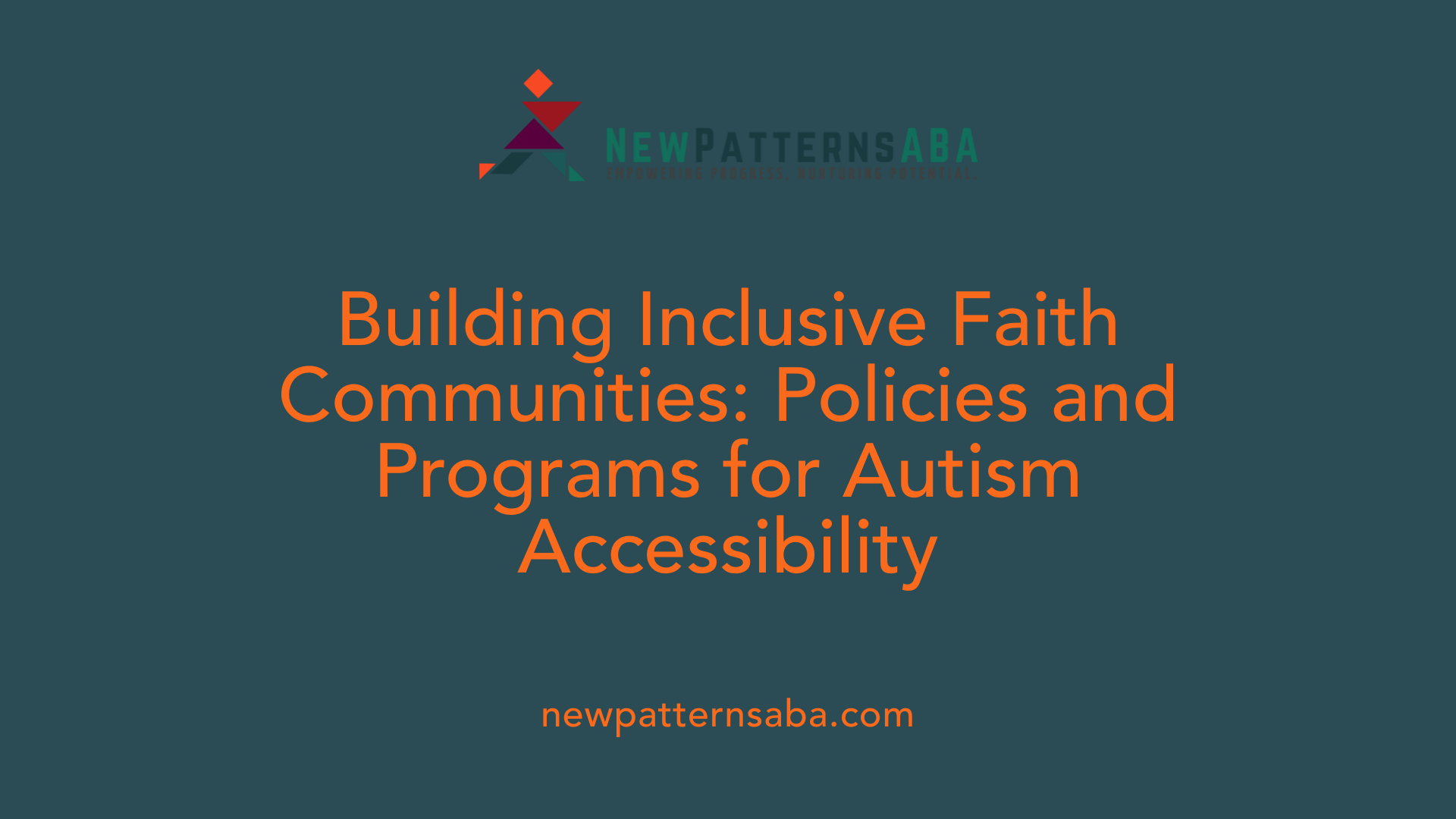Understanding the Need for Autism Accessibility in Religious Services
Religious services offer spiritual community and belonging but can present sensory and social challenges for autistic individuals. Recognizing these barriers and implementing thoughtful, evidence-based strategies can transform religious environments into inclusive spaces where all can participate meaningfully. This article explores practical approaches, grounded in behavioral science and compassionate inclusivity, to make religious gatherings more accessible for autistic attendees.
Recognizing Sensory and Social Barriers in Religious Gatherings

Why are religious gatherings challenging for autistic individuals?
Religious gatherings often present sensory challenges that can be overwhelming for autistic attendees. Crowded spaces filled with loud sounds, bright lights, and unpredictable sensory stimuli may cause sensory overload. Additionally, social expectations such as remaining quiet, sitting still, or engaging appropriately in rituals can be difficult to meet. These factors can make participation challenging and lead to feelings of exclusion or distress.
Sensory challenges in religious environments
Many religious services occur in visually and auditorily stimulating environments. For example, music, chants, and the ringing of bells may be loud, while the lighting might be dim or flickering. The presence of numerous people and physical closeness can be uncomfortable or even anxiety-provoking. Without accommodations like quiet spaces or sensory-friendly adjustments, these environments may discourage autistic individuals from attending or staying throughout the entire service.
Social expectations affecting autistic attendees
Religious doctrines often emphasize certain behavioral norms such as quiet attentiveness, specific social greetings, or communal participation. Autistic individuals might struggle with these expectations due to differences in social communication and interaction styles. Pressure to conform to unwritten social rules can increase stress and reduce meaningful engagement.
How do religious doctrines influence accessibility?
Religious beliefs and doctrinal teachings shape the norms and practices of faith communities, influencing how members behave and interact. Understanding these foundations is vital for creating inclusive environments. By aligning inclusion efforts with the core values of compassion, acceptance, and community found in many faiths, religious organizations can more effectively address accessibility challenges and cultivate welcoming spaces for autistic individuals. This approach respects both the spiritual traditions and the diverse needs of attendees.
The Role of Applied Behavior Analysis (ABA) Therapy in Autism Inclusion

What is applied behavior analysis (ABA) therapy?
Applied Behavior Analysis (ABA) therapy is a scientifically grounded approach that utilizes learning principles and operant conditioning to help increase desirable behaviors and reduce behaviors that interfere with learning or social participation. It is highly personalized, focusing on the unique needs of individuals with autism, and delivered by trained professionals such as Board Certified Behavior Analysts (BCBAs).
How does ABA therapy benefit individuals with autism?
ABA therapy supports the development of critical skills including communication, social interaction, daily living routines, and emotional regulation. When introduced early and with sufficient intensity, ABA can significantly improve developmental outcomes, promoting greater independence and enhanced participation within community and faith settings.
What techniques are commonly used in ABA therapy?
ABA utilizes a variety of techniques tailored to build functional and meaningful skills:
- Discrete Trial Training (DTT): Structured teaching sessions focusing on specific skills.
- Natural Environment Training (NET): Learning skills during everyday activities.
- Task Analysis: Breaking down complex behaviors into smaller, manageable steps.
- Visual Aids: Using images and schedules to support understanding.
- Prompting and Fading: Gradually reducing assistance to encourage independent behavior.
- Modeling: Demonstrating desired behaviors for imitation.
- Reinforcement Strategies: Employing positive praise, token systems, or preferred items to encourage repetition of positive behaviors.
These strategies help individuals assimilate into social and sensory environments such as religious gatherings.
Who provides ABA therapy?
Certified professionals, including BCBAs and trained therapists, conduct assessments and develop individualized intervention plans. They implement therapy in various settings—homes, schools, clinics, and community environments—to ensure support is continuous and contextually relevant.
| Aspect | Details | Relevance to Religious Inclusion |
|---|---|---|
| Definition | Science-based behavioral intervention using operant conditioning | Helps tailor supports to individual needs in worship and community events |
| Benefits | Improves communication, social skills, emotional regulation | Enables fuller participation in religious services and social activities |
| Techniques | DTT, NET, task analysis, prompting, modeling, reinforcement | Supports skill-building for navigating sensory/social complexities in faith settings |
| Providers | BCBAs, therapists in varied environments | Ensure professional, individualized care within inclusive religious programming |
Practical Strategies for Making Religious Services Autism-Friendly

How can religious services be adapted to support autistic individuals?
Adapting religious services to cater to autistic attendees involves creating a multisensory and inclusive worship environment. Key adaptations include minimizing sensory overload by adjusting lighting and noise levels. Providing quiet spaces or sensory rooms offers a calming retreat when needed.
Visual supports such as social narratives and visual schedules help prepare autistic individuals for unfamiliar routines or activities, reducing anxiety and encouraging engagement. Incorporating these supports allows participants to anticipate service flow and understand expectations clearly.
What preparation helps autistic children before attending services?
Preparation is essential to ease autistic children into religious services. Visiting the venue beforehand familiarizes the child with the environment. Sharing visual schedules or service programs in advance helps set clear expectations.
Reserving suitable seating accommodates sensory sensitivities or the need for space. Explaining participation steps, such as when to greet others, assists in social understanding. Additionally, planning for potential early departures ensures flexibility and comfort for both child and caregivers.
How can behavior techniques support attendance and participation?
Behavioral strategies rooted in Applied Behavior Analysis (ABA) can effectively support attendance and participation. Starting with short attendance durations during service, perhaps the last few minutes, allows gradual acclimation.
Reinforcers like preferred items or snacks are provided contingent on on-task behavior. Attendance duration is increased systematically with fading procedures, gradually extending time in service as positive behavior is maintained.
If disruptive behavior arises, redirecting to a less disruptive space allows the individual to regroup while still engaging.
Additional Suggestions for Inclusion
- Training staff and volunteers on autism awareness enhances responsiveness.
- Communication with families helps tailor accommodations and behavior plans.
- Celebrating individual strengths and encouraging peer mentorship fosters belonging.
These combined strategies ensure services are accessible, comfortable, and welcoming to autistic individuals, promoting meaningful participation and community inclusion.
Community and Congregational Involvement for Autism Inclusion
Why is educating the religious community about autism important?
Educating congregations about autism is essential for building understanding and reducing stigma within faith communities. When congregants learn about autism, they develop greater empathy and awareness, which encourages autism-friendly practices. This education helps create a welcoming space where autistic individuals and their families feel accepted and supported, enhancing their meaningful participation in religious life.
How can autistic people be included in faith community decisions?
Involving autistic individuals directly in the decision-making processes of faith communities ensures their unique needs and gifts are acknowledged and valued. This participation empowers autistic people by giving them a voice in shaping accommodations and programs, promoting genuine inclusion rather than token gestures. Faith communities that listen and respond to autistic members build stronger, more compassionate environments.
What role do attitudes and acceptance play in inclusion?
Attitudes within faith communities profoundly impact inclusion efforts. Embracing the uniqueness of autistic behaviors—including communication styles and social interactions—allows congregations to appreciate diversity fully. Acceptance involves patience and a willingness to undergo cultural change, recognizing that quirks and differences form part of the community identity. This attitude shift fosters sustainable, autism-friendly environments where every member belongs.
Celebrating Gifts and Sharing Needs
Faith communities thrive when they celebrate the individual strengths and contributions of all members. Openly sharing needs alongside gifts promotes mutual understanding and support. This culture of openness helps dismantle barriers and stigmas, encouraging everyone to participate fully in worship and community life.
Taken together, education, involvement, positive attitudes, and shared celebration create a foundation for a truly inclusive and supportive faith community that nurtures autistic individuals and their families.
Developing Policies and Programs to Support Accessibility

How can churches formalize their autism accessibility efforts?
Churches can formalize their commitment to autism inclusion by adopting official Church Policies on Accessibility. Using available templates for these policies helps ensure that accommodations are consistently applied and monitored across all services and activities. A formal policy not only signals the church's dedication to accessibility but also provides clear guidelines for staff and volunteers to follow.
What are effective programs to support autistic participants?
Implementing buddy systems is a highly effective way to encourage social interaction and inclusion for autistic individuals. These programs pair autistic attendees with supportive peers who can help them navigate the social and sensory complexities of religious gatherings.
Specialized programs such as dedicated classrooms, sensory rooms, family support groups, and respite care are equally important. These offerings provide tailored environments and support structures, addressing the varied needs of autistic individuals and their families. This comprehensive approach fosters a sense of belonging and community within the faith setting.
What resources guide religious organizations in inclusion practices?
Religious organizations seeking guidance on autism inclusion can turn to resources like Ann Memmott’s 'Welcoming and Including Autistic People in Our Churches and Communities.' This publication offers practical advice centered on understanding autistic communication styles and sensory processing. It emphasizes creating welcoming environments that respect individual differences and promote genuine inclusion.
By combining formal policies, targeted programs, and expert resources, churches can create environments where autistic individuals are valued, supported, and able to participate meaningfully in their faith communities.
Behavioral Monitoring and Individualized Goal Setting in Religious Contexts
How Is Meaningful Participation Defined in Religious Settings for Autistic Individuals?
Meaningful participation centers on an individual's ability to engage actively and appropriately during religious services. This involves setting personalized definitions of what constitutes on-task behavior—such as listening attentively or participating quietly—and off-task behavior, tailored to each person's capacities and needs.
What Data Collection Methods Support These Goals?
Interval recording is a practical method to monitor attendance behavior systematically. By observing and recording whether the individual remains on-task during set time intervals, organizers can gather objective data to track progress and make informed decisions about accommodations.
How Are Attendance Goals Set and Reinforcement Used?
Attendance is increased gradually, starting from short durations like the last few minutes of a service. Small increments allow for manageable progression without overwhelming the individual. Reinforcers, such as preferred items or snacks, are given contingent on on-task behavior. Over time, reinforcement intervals are extended to promote independence. Additionally, systematic fading helps transition from heavily supported attendance to more autonomous participation.
What Is the Strategy for Managing Disruptive Behavior?
If disruptive behavior arises, the individual can be gently redirected to a less stimulating area within the space. From there, attendance duration is cautiously rebuilt using the same incremental approach, ensuring comfort and continued progress. Teaching strategies also recommend starting with familiar instructors to increase security and gradually increasing the physical distance from them to foster independence.
This behavioral monitoring approach aligns with evidence-based practices and emphasizes patience, individualized goals, and ongoing assessment to support autistic individuals' meaningful engagement in religious communities.
Faith Communities as Partners in Early Autism Support and Ongoing Inclusion
Early identification and screening role
Faith communities often serve as vital support hubs, positioned uniquely to aid in early autism screening. By recognizing developmental red flags like delayed language, lack of response to name, or limited social engagement in toddlers as young as two years old, these communities can connect families to diagnostic and intervention resources. Early intervention is crucial for improving communication, social skills, and behavior development.
Supporting families with autism
Faith communities support families by fostering open conversations about needs and by creating welcoming, accommodating environments. Offering existing program adaptations and launching new initiatives—such as support groups and respite care—can significantly relieve families facing autism-related challenges. Educating congregations about autism and sharing real stories also nurtures understanding and acceptance.
Creating inclusive programs and accommodations
Inclusive efforts include minimizing sensory overload through lighting and noise adjustments, providing quiet or sensory rooms, and developing buddy systems to promote social interaction. Specialized classrooms and family support groups honor individual strengths and reduce feelings of rejection, helping participation.
Communication techniques and transition strategies
Effective communication involves simple language, direct interaction, and use of visual aids or AAC tools tailored to individual needs. Employing social narratives, visual schedules, timers, and gentle transition warnings helps reduce anxiety and improves engagement. These methods make religious activities predictable and accessible, encouraging full participation.
Building Truly Inclusive Worship Communities
Creating religious services that welcome and support autistic individuals requires a comprehensive approach blending empathy, evidence-based behavioral strategies, and community engagement. Through education, thoughtful accommodations, individualized supports, and inclusive policies, faith communities can transform worship spaces into places where everyone, regardless of neurodiversity, experiences belonging and spiritual growth. This ongoing journey demands patience and willingness to learn, fostering hope for a future where autism accessibility is a foundational aspect of communal faith life.
References
- Welcoming Autistic People to Religious Gatherings
- Teaching Children with Autism To Attend Religious Services
- Tips for Disability Accommodation in Church and Ministry ...
- Religious Services and ASD | CHOP Research Institute
- Autism and Faith Communities:
- 5 Ways Your Church Can Be More Inclusive for People ...
- Applied Behavior Analysis (ABA)
- Applied Behavior Analysis (ABA)
- 6 Benefits of ABA Therapy for Children with Autism
- ABA Techniques: Strategies for Behavior Analysts - GSEP Blog





